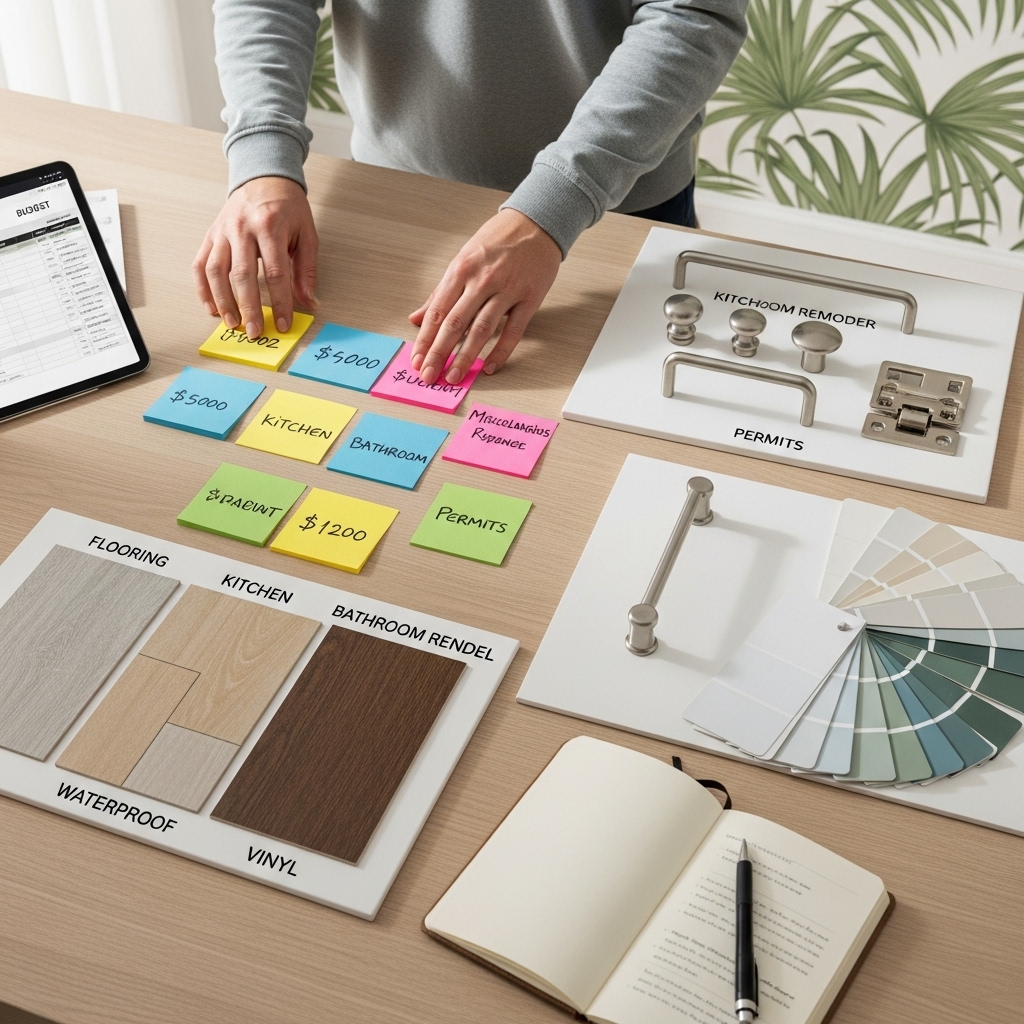Smart Budgeting for Coastal Renovations
Creating a beautiful, durable home in Huntington Beach starts with a plan that protects both your lifestyle and your financial priorities. While every property is unique, there are universal strategies that help you get more from your renovation investment without sacrificing quality. In the sections below, you will learn how to define scope, phase work intelligently, and select materials that thrive in salt air and sun. For a smoother path from vision to reality, consider the advantages of design-build coordination for your home renovation so decisions, drawings, and construction stay aligned.
Budget stewardship is about clarity and timing as much as materials. Thoughtful preparation reduces change orders and schedule drift. You can stretch impact with well-chosen focal elements, smart lighting, and durable surfaces that age gracefully by the beach.
Define Priorities and Protect the Core Scope
Begin with your top three outcomes—more storage, better light, improved ventilation, or an open plan—and protect them during design refinement. When trade-offs arise, having priorities documented helps you maintain momentum. Create a simple tiered list of must-haves and alternates so your team can offer quick options that preserve the big picture.
Leverage Phasing Without Losing Cohesion
Phasing can be a powerful budgeting tool, especially for occupied renovations. Group work by systems—electrical rough-ins, plumbing risers, or HVAC zoning—so early phases do not require rework later. For example, if you are updating a kitchen now and a bath next year, rough-in capacity and routes for both during the first phase to avoid opening walls twice.
Choose Materials for Durability and Ease of Care
Salt air, humidity, and sandy traffic challenge finishes. Favor corrosion-resistant hardware, sealed edges, and moisture-tolerant substrates. In high-traffic areas, consider hard-wearing floors that clean easily. In baths, robust membranes, well-sloped pans, and quiet, high-capacity exhaust improve longevity. Material resilience minimizes future maintenance and disruption.
Standardize Where It Makes Sense
Use standard door sizes, cabinet modules, and trim profiles to reduce customization. Consistency in profiles and finish sheen creates a cohesive, high-quality feel even with a mix of material tiers. Save bespoke detailing for focal areas like a kitchen island, a statement backsplash, or a built-in media wall that anchors the living space.
Prioritize Light, Ventilation, and Storage
Improvements you feel every day—good lighting layers, natural airflow, and organized storage—deliver outsized value. Plan general illumination, task lighting, and accent lighting to work together. Specify quiet fans on timers or humidity sensors in baths and laundry areas. Build storage that anticipates real life: tray dividers, pullouts, and adjustable shelves. These upgrades elevate daily living without adding complexity.
Document Decisions and Reduce Changes
Late choices create ripple effects. Collect finish samples early and confirm edge treatments, reveals, and transitions in the drawings. Maintain a selections schedule with model numbers, colors, and install notes. A well-documented plan helps the field team install efficiently and prevents rework.
Plan for Huntington Beach Permitting and Review
Even modest scopes may require permits and inspections. If you live in an HOA community, align with design guidelines and meeting calendars. Begin energy compliance and green building paperwork early so approvals do not slow your schedule. The earlier your documents are complete, the easier it is to forecast lead times and coordinate trades.
Protect Living Areas During Construction
Dust, noise, and access control are budget issues because they influence schedule and rework risk. Require solid protection plans: zipper walls, floor coverings, and negative air where needed. Establish delivery routes and a daily cleanup routine. The smoother site logistics are, the fewer disruptions you experience.
Value Engineering with Intention
Value engineering is most effective when guided by your priorities. Ask your team to provide two or three alternates for finishes that do not affect durability or code compliance. Consider simplifying cabinet door styles, using standard tile sizes, or selecting hardware in readily available finishes. In contrast, keep robust ventilation, waterproofing, and weatherproofing as non-negotiable pillars.
Coastal Exterior Touchpoints
At doors and windows, use marine-friendly fasteners, compatible sealants, and proper flashing. For decks and outdoor kitchens, plan drainage and shade to protect surfaces. These details reduce maintenance and preserve the look and function of your investment.
Kitchen-Specific Savings That Do Not Sacrifice Quality
- Use standard cabinet widths to minimize fillers and customization.
- Specify durable, easy-clean backsplash materials in high-splash zones.
- Plan power on islands with concealed outlets to avoid retrofits.
- Leverage drawer organizers and pullouts instead of more cabinetry.
- Balance appliance capacity with actual cooking habits and ventilation needs.
Bathroom-Specific Savings with Lasting Impact
- Invest in premium waterproofing, then choose streamlined tile patterns.
- Use niches and ledges for storage instead of extra cabinetry.
- Right-size exhaust fans and add timers or sensors.
- Choose slip-resistant flooring with easy maintenance.
- Plan lighting layers: overhead, task at the mirror, and soft night lighting.
Coordinate Early with Trades
Meet your electrician, plumber, and HVAC contractor before drywall to confirm locations and heights. These conversations prevent conflicts between recessed lights and duct runs, or between cabinet crown and sprinkler heads in multi-unit buildings. Early buy-in translates to fewer change orders and a steadier schedule.
Living Through Renovation
If you will remain in the home, plan zones: a temporary kitchen with induction plate and sink access, protected pathways, and quiet hours for the noisiest tasks. Pack and label items to be stored, then stage rooms so crews can move efficiently. These steps minimize disruption and help the project keep its rhythm.
Mid-Project Course Corrections
It is normal to refine small details during construction, but keep changes focused. Use a simple change approval process with documented scope, schedule impact, and updated drawings. Protect critical path items—inspections, long-lead finishes, and countertop measure dates—so refinements do not extend the timeline.
When choices feel overwhelming, return to your core goals and let them guide you. A seasoned design-build partner can translate priorities into cohesive drawings and a leaner construction sequence. If you prefer a single point of accountability, a coordinated home renovation process can manage design decisions, permitting, and field execution under one roof.
Checklist: Stretch Every Dollar with Good Planning
- List must-haves and nice-to-haves and rank them.
- Document existing conditions and verify utilities and panel capacity.
- Build a selections schedule early and confirm lead times.
- Group work by systems to enable efficient phasing.
- Standardize sizes and profiles where possible.
- Protect exterior openings, thresholds, and decks against salt air.
- Plan robust waterproofing and ventilation in baths and kitchens.
- Schedule weekly check-ins and maintain clear meeting notes.
- Confirm inspection milestones and site logistics before start.
- Close out with a punch list and a labeled warranty binder.
Frequently Asked Questions
Q: How can I keep scope from growing? A: Write a clear scope narrative and stick to priorities. Capture ideas for the future in a “Phase Two” list to preserve momentum now.
Q: Are there coastal materials I should always choose? A: Favor corrosion-resistant hardware and moisture-tolerant substrates. In wet rooms, invest in waterproofing and ventilation first.
Q: What if I need to pause between phases? A: Plan clean breakpoints—fully finish a bath or a bedroom—so the home functions well while you regroup.
Q: How do I involve my HOA? A: Submit early and provide clear visuals. Align exterior finishes and hardware with guidelines to streamline approvals.
Q: What are the best ways to avoid rework? A: Confirm dimensions at field measure, hold coordination meetings, and finalize selections before ordering.
Q: Can lighting really change the feel of my home? A: Absolutely. Proper layers of light elevate materials, improve function, and can make smaller rooms feel more open and inviting.
Move Forward with Confidence
Smart planning, thoughtful material choices, and clear communication make coastal renovations more predictable and rewarding. When you are ready to transform your Huntington Beach home, choose a partner who manages design and construction seamlessly. Begin your journey by exploring a trusted resource for comprehensive home renovation guidance and collaboration tailored to Surf City living.

